Git from the inside out
2016-10-28 10:54
323 查看

code words – issue two
Git from the inside out
Mary Rose CookThis essay explains how Git works. It assumes you understand Git well enough to use it to version control your projects.
The essay focuses on the graph structure that underpins Git and the way the properties of this graph dictate Git’s behavior. Looking at fundamentals, you build your mental model on the truth
rather than on hypotheses constructed from evidence gathered while experimenting with the API. This truer model gives you a better understanding of what Git has done, what it is doing, and what it will do.
The text is structured as a series of Git commands run on a single project. At intervals, there are observations about the graph data structure that Git is built on. These observations illustrate
a property of the graph and the behavior that this property produces.
After reading, if you wish to go even deeper into Git, you can look at the heavily
annotated source code of my implementation of Git in JavaScript.
Create the project
~ $ mkdir alpha ~ $ cd alpha
The user creates
alpha,
a directory for their project.
~/alpha $ mkdir data ~/alpha $ printf 'a' > data/letter.txt
They move into the
alphadirectory
and create a directory called
data.
Inside, they create a file called
letter.txtthat
contains
a. The alpha directory looks
like this:
alpha └── data └── letter.txt
Initialize the repository
~/alpha $ git init Initialized empty Git repository
git initmakes the current directory into a Git repository. To do this, it creates a
.gitdirectory
and writes some files to it. These files define everything about the Git configuration and the history of the project. They are just ordinary files. No magic in them. The user can read and edit them with a text editor or shell. Which is to say: the user can
read and edit the history of their project as easily as their project files.
The
alphadirectory
now looks like this:
alpha ├── data | └── letter.txt └── .git ├── objects etc...
The
.gitdirectory
and its contents are Git’s. All the other files are collectively known as the working copy. They are the user’s.
Add some files
~/alpha $ git add data/letter.txt
The user runs
git addon
data/letter.txt. This
has two effects.
First, it creates a new blob file in the
.git/objects/directory.
This blob file contains the compressed content of
data/letter.txt.
Its name is derived by hashing its content. Hashing a piece of text means running a program on it that turns it into a smaller1 piece
of text that uniquely2 identifies
the original. For example, Git hashes
ato
2e65efe2a145dda7ee51d1741299f848e5bf752e.
The first two characters are used as the name of a directory inside the objects database:
.git/objects/2e/.
The rest of the hash is used as the name of the blob file that holds the content of the added file:
.git/objects/2e/65efe2a145dda7ee51d1741299f848e5bf752e.
Notice how just adding a file to Git saves its content to the
objectsdirectory.
Its content will still be safe inside Git if the user deletes
data/letter.txtfrom
the working copy.
Second,
git addadds the file to the index. The index is a list that contains every file that Git has been told to keep track of. It is stored as a file at
.git/index.
Each line of the file maps a tracked file to the hash of its content at the moment it was added. This is the index after the
git addcommand is run:
data/letter.txt 2e65efe2a145dda7ee51d1741299f848e5bf752e
The user makes a file called
data/number.txtthat
contains
1234.
~/alpha $ printf '1234' > data/number.txt
The working copy looks like this:
alpha └── data └── letter.txt└── number.txt
The user adds the file to Git.
~/alpha $ git add data
The
git addcommand creates a blob object that contains the content of
data/number.txt.
It adds an index entry for
data/number.txtthat
points at the blob. This is the index after the
git addcommand is run a second time:
data/letter.txt 2e65efe2a145dda7ee51d1741299f848e5bf752edata/number.txt 274c0052dd5408f8ae2bc8440029ff67d79bc5c3
Notice that only the files in the
datadirectory
are listed in the index, though the user ran
git add data. The
datadirectory
is not listed separately.
~/alpha $ printf '1' > data/number.txt
~/alpha $ git add data
When the user originally created
data/number.txt,
they meant to type
1, not
1234.
They make the correction and add the file to the index again. This command creates a new blob with the new content. And it updates the index entry for
data/number.txtto
point at the new blob.
Make a commit
~/alpha $ git commit -m 'a1' [master (root-commit) 774b54a] a1
The user makes the
a1commit.
Git prints some data about the commit. These data will make sense shortly.
The commit command has three steps. It creates a tree graph to represent the content of the version of the project being committed. It creates a commit object. It points the current branch
at the new commit object.
Create a tree graph
Git records the current state of the project by creating a tree graph from the index. This tree graph records the location and content of every file in the project.The graph is composed of two types of object: blobs and trees.
Blobs are stored by
git add. They represent the content of files.
Trees are stored when a commit is made. A tree represents a directory in the working copy.
Below is the tree object that records the contents of the
datadirectory
for the new commit:
100664 blob 2e65efe2a145dda7ee51d1741299f848e5bf752e letter.txt 100664 blob 56a6051ca2b02b04ef92d5150c9ef600403cb1de number.txt
The first line records everything required to reproduce
data/letter.txt.
The first part states the file’s permissions. The second part states that the content of this entry is represented by a blob, rather than a tree. The third part states the hash of the blob. The fourth part states the file’s name.
The second line records the same for
data/number.txt.
Below is the tree object for
alpha,
which is the root directory of the project:
040000 tree 0eed1217a2947f4930583229987d90fe5e8e0b74 data
The sole line in this tree points at the
datatree.

Tree graph for the `a1` commit
In the graph above, the
roottree
points at the
datatree. The
datatree
points at the blobs for
data/letter.txtand
data/number.txt.
Create a commit object
git commitcreates a commit object after creating the tree graph. The commit object is just another text file in
.git/objects/:
tree ffe298c3ce8bb07326f888907996eaa48d266db4 author Mary Rose Cook <mary@maryrosecook.com> 1424798436 -0500 committer Mary Rose Cook <mary@maryrosecook.com> 1424798436 -0500 a1
The first line points at the tree graph. The hash is for the tree object that represents the root of the working copy. That is: the
alphadirectory.
The last line is the commit message.

`a1` commit object pointing at its tree graph
Point the current branch at the new commit
Finally, the commit command points the current branch at the new commit object.Which is the current branch? Git goes to the
HEADfile
at
.git/HEADand finds:
ref: refs/heads/master
This says that
HEADis
pointing at
master.
masteris
the current branch.
HEADand
masterare
both refs. A ref is a label used by Git or the user to identify a specific commit.
The file that represents the
masterref
does not exist, because this is the first commit to the repository. Git creates the file at
.git/refs/heads/masterand
sets its content to the hash of the commit object:
74ac3ad9cde0b265d2b4f1c778b283a6e2ffbafd
(If you are typing in these Git commands as you read, the hash of your
a1commit
will be different from the hash of mine. Content objects like blobs and trees always hash to the same value. Commits do not, because they include dates and the names of their creators.)
Let’s add
HEADand
masterto
the Git graph:

`HEAD` pointing at `master` and `master` pointing at the `a1` commit
HEADpoints
at
master, as it did before the commit.
But
masternow exists and points at
the new commit object.
Make a commit that is not the first commit
Below is the Git graph after the a1commit.
The working copy and index are included.

`a1` commit shown with the working copy and index
Notice that the working copy, index, and
a1commit
all have the same content for
data/letter.txtand
data/number.txt.
The index and
HEADcommit both use
hashes to refer to blob objects, but the working copy content is stored as text in a different place.
~/alpha $ printf '2' > data/number.txt
The user sets the content of
data/number.txtto
2.
This updates the working copy, but leaves the index and
HEADcommit
as they are.

`data/number.txt` set to `2` in the working copy
~/alpha $ git add data/number.txt
The user adds the file to Git. This adds a blob containing
2to
the
objectsdirectory. It points the
index entry for
data/number.txtat
the new blob.

`data/number.txt` set to `2` in the working copy and index
~/alpha $ git commit -m 'a2' [master f0af7e6] a2
The user commits. The steps for the commit are the same as before.
First, a new tree graph is created to represent the content of the index.
The index entry for
data/number.txthas
changed. The old
datatree no longer
reflects the indexed state of the
datadirectory.
A new
datatree object must be created:
100664 blob 2e65efe2a145dda7ee51d1741299f848e5bf752e letter.txt 100664 blob d8263ee9860594d2806b0dfd1bfd17528b0ba2a4 number.txt
The new
datatree
hashes to a different value from the old
datatree.
A new
roottree must be created to
record this hash:
040000 tree 40b0318811470aaacc577485777d7a6780e51f0b data
Second, a new commit object is created.
tree ce72afb5ff229a39f6cce47b00d1b0ed60fe3556 parent 774b54a193d6cfdd081e581a007d2e11f784b9fe author Mary Rose Cook <mary@maryrosecook.com> 1424813101 -0500 committer Mary Rose Cook <mary@maryrosecook.com> 1424813101 -0500 a2
The first line of the commit object points at the new
roottree
object. The second line points at
a1:
the commit’s parent. To find the parent commit, Git went to
HEAD,
followed it to
masterand found the
commit hash of
a1.
Third, the content of the
masterbranch
file is set to the hash of the new commit.

`a2` commit

Git graph without the working copy and index
Graph property: content is stored as a tree of objects. This means that only diffs are stored in the objects database. Look at the graph above. The
a2commit
reuses the
ablob that was made before
the
a1commit. Similarly, if a whole
directory doesn’t change from commit to commit, its tree and all the blobs and trees below it can be reused. Generally, there are few content changes from commit to commit. This means that Git can store large commit histories in a small amount of space.
Graph property: each commit has a parent. This means that a repository can store the history of a project.
Graph property: refs are entry points to one part of the commit history or another. This means that commits can be given meaningful names. The user organizes their work
into lineages that are meaningful to their project with concrete refs like
fix-for-bug-376.
Git uses symbolic refs like
HEAD,
MERGE_HEADand
FETCH_HEADto
support commands that manipulate the commit history.
Graph property: the nodes in the
objects/directory
are immutable. This means that content is edited, not deleted. Every piece of content ever added and every commit ever made is somewhere in the
objectsdirectory3.
Graph property: refs are mutable. Therefore, the meaning of a ref can change. The commit that
masterpoints
at might be the best version of a project at the moment, but, soon enough, it will be superseded by a newer and better commit.
Graph property: the working copy and the commits pointed at by refs are readily available, but other commits are not. This means that recent history is easier to recall,
but that it also changes more often. Or: Git has a fading memory that must be jogged with increasingly vicious prods.
The working copy is the easiest point in history to recall because it is in the root of the repository. Recalling it doesn’t even require a Git command. It is also the least permanent point
in history. The user can make a dozen versions of a file but Git won’t record any of them unless they are added.
The commit that
HEADpoints
at is very easy to recall. It is at the tip of the branch that is checked out. To see its content, the user can just stash4 and
then examine the working copy. At the same time,
HEADis
the most frequently changing ref.
The commit that a concrete ref points at is easy to recall. The user can simply check out that branch. The tip of a branch changes less often than
HEAD,
but often enough for the meaning of a branch name to be changeable.
It is difficult to recall a commit that is not pointed at by any ref. The further the user goes from a ref, the harder it will be for them to construct the meaning of a commit. But the further
back they go, the less likely it is that someone will have changed history since they last looked5.
Check out a commit
~/alpha $ git checkout 37888c2 You are in 'detached HEAD' state...
The user checks out the
a2commit
using its hash. (If you are running these Git commands, this one won’t work. Use
git logto find the hash of your
a2commit.)
Checking out has four steps.
First, Git gets the
a2commit
and gets the tree graph it points at.
Second, it writes the file entries in the tree graph to the working copy. This results in no changes. The working copy already has the content of the tree graph being written to it because
HEADwas
already pointing via
masterat the
a2commit.
Third, Git writes the file entries in the tree graph to the index. This, too, results in no changes. The index already has the content of the
a2commit.
Fourth, the content of
HEADis
set to the hash of the
a2commit:
f0af7e62679e144bb28c627ee3e8f7bdb235eee9
Setting the content of
HEADto
a hash puts the repository in the detached
HEADstate.
Notice in the graph below that
HEADpoints
directly at the
a2commit, rather
than pointing at
master.

Detached `HEAD` on `a2` commit
~/alpha $ printf '3' > data/number.txt
~/alpha $ git add data/number.txt~/alpha $ git commit -m 'a3'
[detached HEAD 3645a0e] a3
The user sets the content of
data/number.txtto
3and
commits the change. Git goes to
HEADto
get the parent of the
a3commit. Instead
of finding and following a branch ref, it finds and returns the hash of the
a2commit.
Git updates
HEADto
point directly at the hash of the new
a3commit.
The repository is still in the detached
HEADstate.
It is not on a branch because no commit points at either
a3or
one of its descendants. This means it is easy to lose.
From now on, trees and blobs will mostly be omitted from the graph diagrams.

`a3` commit that is not on a branch
Create a branch
~/alpha $ git branch deputy
The user creates a new branch called
deputy.
This just creates a new file at
.git/refs/heads/deputythat
contains the hash that
HEADis pointing
at: the hash of the
a3commit.
Graph property: branches are just refs and refs are just files. This means that Git branches are lightweight.
The creation of the
deputybranch
puts the new
a3commit safely on a
branch.
HEADis still detached because
it still points directly at a commit.

`a3` commit now on the `deputy` branch
Check out a branch
~/alpha $ git checkout master Switched to branch 'master'
The user checks out the
masterbranch.
First, Git gets the
a2commit
that
masterpoints at and gets the
tree graph the commit points at.
Second, Git writes the file entries in the tree graph to the files of the working copy. This sets the content of
data/number.txtto
2.
Third, Git writes the file entries in the tree graph to the index. This updates the entry for
data/number.txtto
the hash of the
2blob.
Fourth, Git points
HEADat
masterby
changing its content from a hash to:
ref: refs/heads/master

`master` checked out and pointing at the `a2` commit
Check out a branch that is incompatible with the working copy
~/alpha $ printf '789' > data/number.txt ~/alpha $ git checkout deputy Your changes to these files would be overwritten by checkout: data/number.txt Commit your changes or stash them before you switch branches.
The user accidentally sets the content of
data/number.txtto
789.
They try to check out
deputy. Git prevents
the check out.
HEADpoints
at
masterwhich points at
a2where
data/number.txtreads
2.
deputypoints
at
a3where
data/number.txtreads
3.
The working copy version of
data/number.txtreads
789.
All these versions are different and the differences must be resolved.
Git could replace the working copy version of
data/number.txtwith
the version in the commit being checked out. But it avoids data loss at all costs.
Git could merge the working copy version with the version being checked out. But this is complicated.
So, Git aborts the check out.
~/alpha $ printf '2' > data/number.txt~/alpha $ git checkout deputy
Switched to branch 'deputy'
The user notices that they accidentally edited
data/number.txtand
sets the content back to
2. They check
out
deputysuccessfully.

`deputy` checked out
Merge an ancestor
~/alpha $ git merge master Already up-to-date.
The user merges
masterinto
deputy.
Merging two branches means merging two commits. The first commit is the one that
deputypoints
at: the receiver. The second commit is the one that
masterpoints
at: the giver. For this merge, Git does nothing. It reports it is
Already up-to-date..
Graph property: the series of commits in the graph are interpreted as a series of changes made to the content of the repository. This means that, in a merge, if the giver
commit is an ancestor of the receiver commit, Git will do nothing. Those changes have already been incorporated.
Merge a descendent
~/alpha $ git checkout master Switched to branch 'master'
The user checks out
master.

`master` checked out and pointing at the `a2` commit
~/alpha $ git merge deputy Fast-forward
They merge
deputyinto
master.
Git discovers that the receiver commit,
a2,
is an ancestor of the giver commit,
a3.
It can do a fast-forward merge.
It gets the giver commit and gets the tree graph that it points at. It writes the file entries in the tree graph to the working copy and the index. It “fast-forwards”
masterto
point at
a3.

`a3` commit from `deputy` fast-forward merged into `master`
Graph property: the series of commits in the graph are interpreted as a series of changes made to the content of the repository. This means that, in a merge, if the giver
is a descendent of the receiver, history is not changed. There is already a sequence of commits that describe the change to make: the sequence of commits between the receiver and the giver. But, though the Git history doesn’t change, the Git graph does change.
The concrete ref that
HEADpoints
at is updated to point at the giver commit.
Merge two commits from different lineages
~/alpha $ printf '4' > data/number.txt
~/alpha $ git add data/number.txt~/alpha $ git commit -m 'a4'
[master 7b7bd9a] a4
The user sets the content of
number.txtto
4and
commits the change to
master.
~/alpha $ git checkout deputy
Switched to branch 'deputy'
~/alpha $ printf 'b' > data/letter.txt
~/alpha $ git add data/letter.txt~/alpha $ git commit -m 'b3'
[deputy 982dffb] b3
The user checks out
deputy.
They set the content of
data/letter.txtto
band
commit the change to
deputy.
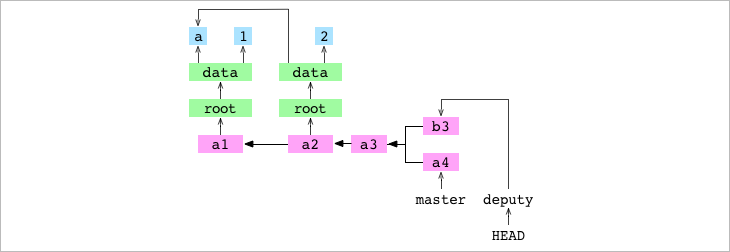
`a4` committed to `master`, `b3` committed to `deputy` and `deputy` checked out
Graph property: commits can share parents. This means that new lineages can be created in the commit history.
Graph property: commits can have multiple parents. This means that separate lineages can be joined by a commit with two parents: a merge commit.
~/alpha $ git merge master -m 'b4' Merge made by the 'recursive' strategy.
The user merges
masterinto
deputy.
Git discovers that the receiver,
b3,
and the giver,
a4, are in different
lineages. It makes a merge commit. This process has eight steps.
First, Git writes the hash of the giver commit to a file at
alpha/.git/MERGE_HEAD.
The presence of this file tells Git it is in the middle of merging.
Second, Git finds the base commit: the most recent ancestor that the receiver and giver commits have in common.

`a3`, the base commit of `a4` and `b3`
Graph property: commits have parents. This means that it is possible to find the point at which two lineages diverged. Git traces backwards from
b3to
find all its ancestors and backwards from
a4to
find all its ancestors. It finds the most recent ancestor shared by both lineages,
a3.
This is the base commit.
Third, Git generates the indices for the base, receiver and giver commits from their tree graphs.
Fourth, Git generates a diff that combines the changes made to the base by the receiver commit and the giver commit. This diff is a list of file paths that point to a change: add, remove, modify
or conflict.
Git gets the list of all the files that appear in the base, receiver or giver indices. For each one, it compares the index entries to decide the change to make to the file. It writes a corresponding
entry to the diff. In this case, the diff has two entries.
The first entry is for
data/letter.txt.
The content of this file is
ain the
base,
bin the receiver and
ain
the giver. The content is different in the base and receiver. But it is the same in the base and giver. Git sees that the content was modified by the receiver, but not the giver. The diff entry for
data/letter.txtis
a modification, not a conflict.
The second entry in the diff is for
data/number.txt.
In this case, the content is the same in the base and receiver, and different in the giver. The diff entry for
data/letter.txtis
also a modification.
Graph property: it is possible to find the base commit of a merge. This means that, if a file has changed from the base in just the receiver or giver, Git can automatically
resolve the merge of that file. This reduces the work the user must do.
Fifth, the changes indicated by the entries in the diff are applied to the working copy. The content of
data/letter.txtis
set to
band the content of
data/number.txtis
set to
4.
Sixth, the changes indicated by the entries in the diff are applied to the index. The entry for
data/letter.txtis
pointed at the
bblob and the entry
for
data/number.txtis pointed at
the
4blob.
Seventh, the updated index is committed:
tree 20294508aea3fb6f05fcc49adaecc2e6d60f7e7d parent 982dffb20f8d6a25a8554cc8d765fb9f3ff1333b parent 7b7bd9a5253f47360d5787095afc5ba56591bfe7 author Mary Rose Cook <mary@maryrosecook.com> 1425596551 -0500 committer Mary Rose Cook <mary@maryrosecook.com> 1425596551 -0500 b4
Notice that the commit has two parents.
Eighth, Git points the current branch,
deputy,
at the new commit.
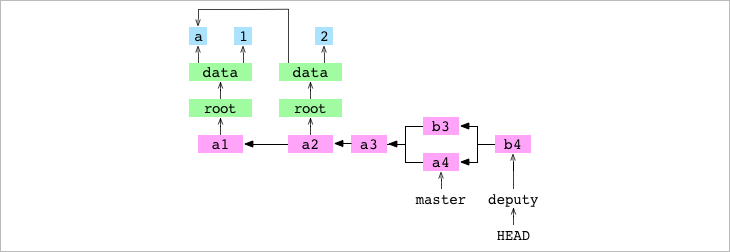
`b4`, the merge commit resulting from the recursive merge of `a4` into `b3`
Merge two commits from different lineages that both modify the same file
~/alpha $ git checkout master Switched to branch 'master'~/alpha $ git merge deputy Fast-forward
The user checks out
master.
They merge
deputyinto
master.
This fast-forwards
masterto the
b4commit.
masterand
deputynow
point at the same commit.
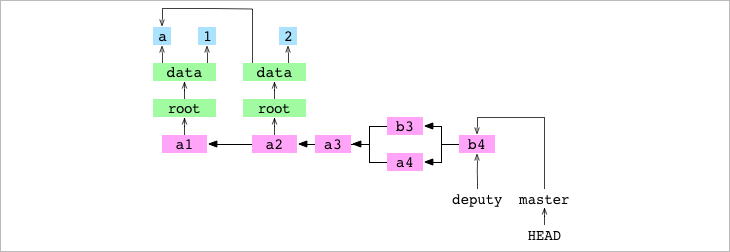
`deputy` merged into `master` to bring `master` up to the latest commit, `b4`
~/alpha $ git checkout deputy
Switched to branch 'deputy'
~/alpha $ printf '5' > data/number.txt
~/alpha $ git add data/number.txt~/alpha $ git commit -m 'b5'
[deputy bd797c2] b5
The user checks out
deputy.
They set the content of
data/number.txtto
5and
commit the change to
deputy.
~/alpha $ git checkout master Switched to branch 'master'~/alpha $ printf '6' > data/number.txt
~/alpha $ git add data/number.txt~/alpha $ git commit -m 'b6'
[master 4c3ce18] b6
The user checks out
master.
They set the content of
data/number.txtto
6and
commit the change to
master.

`b5` commit on `deputy` and `b6` commit on `master`
~/alpha $ git merge deputy CONFLICT in data/number.txt Automatic merge failed; fix conflicts and commit the result.
The user merges
deputyinto
master.
There is a conflict and the merge is paused. The process for a conflicted merge follows the same first six steps as the process for an unconflicted merge: set
.git/MERGE_HEAD,
find the base commit, generate the indices of the base, receiver and giver commits, create a diff, update the working copy and update the index. Because of the conflict, the seventh commit step and eighth ref update step are never taken. Let’s go through the
steps again and see what happens.
First, Git writes the hash of the giver commit to a file at
.git/MERGE_HEAD.
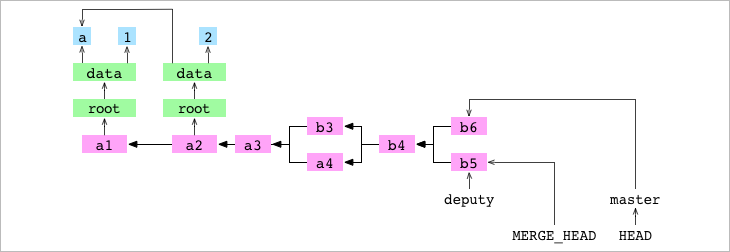
`MERGE_HEAD` written during merge of `b5` into `b6`
Second, Git finds the base commit,
b4.
Third, Git generates the indices for the base, receiver and giver commits.
Fourth, Git generates a diff that combines the changes made to the base by the receiver commit and the giver commit. This diff is a list of file paths that point to a change: add, remove, modify
or conflict.
In this case, the diff contains only one entry:
data/number.txt.
The entry is marked as a conflict because the content for
data/number.txtis
different in the receiver, giver and base.
Fifth, the changes indicated by the entries in the diff are applied to the working copy. For a conflicted area, Git writes both versions to the file in the working copy. The content of
data/number.txtis
set to:
<<<<<<< HEAD 6 ======= 5 >>>>>>> deputy
Sixth, the changes indicated by the entries in the diff are applied to the index. Entries in the index are uniquely identified by a combination of their file path and stage. The entry for an
unconflicted file has a stage of
0.
Before this merge, the index looked like this, where the
0s
are stage values:
0 data/letter.txt 63d8dbd40c23542e740659a7168a0ce3138ea748 0 data/number.txt 62f9457511f879886bb7728c986fe10b0ece6bcb
After the merge diff is written to the index, the index looks like this:
0 data/letter.txt 63d8dbd40c23542e740659a7168a0ce3138ea748 1 data/number.txt bf0d87ab1b2b0ec1a11a3973d2845b42413d9767 2 data/number.txt 62f9457511f879886bb7728c986fe10b0ece6bcb 3 data/number.txt 7813681f5b41c028345ca62a2be376bae70b7f61
The entry for
data/letter.txtat
stage
0is the same as it was before
the merge. The entry for
data/number.txtat
stage
0is gone. There are three new
entries in its place. The entry for stage
1has
the hash of the base
data/number.txtcontent.
The entry for stage
2has the hash
of the receiver
data/number.txtcontent.
The entry for stage
3has the hash
of the giver
data/number.txtcontent.
The presence of these three entries tells Git that
data/number.txtis
in conflict.
The merge pauses.
~/alpha $ printf '11' > data/number.txt
~/alpha $ git add data/number.txt
The user integrates the content of the two conflicting versions by setting the content of
data/number.txtto
11.
They add the file to the index. Git adds a blob containing
11.
Adding a conflicted file tells Git that the conflict is resolved. Git removes the
data/number.txtentries
for stages
1,
2and
3from
the index. It adds an entry for
data/number.txtat
stage
0with the hash of the new blob.
The index now reads:
0 data/letter.txt 63d8dbd40c23542e740659a7168a0ce3138ea748 0 data/number.txt 9d607966b721abde8931ddd052181fae905db503
~/alpha $ git commit -m 'b11' [master 251a513] b11
Seventh, the user commits. Git sees
.git/MERGE_HEADin
the repository, which tells it that a merge is in progress. It checks the index and finds there are no conflicts. It creates a new commit,
b11,
to record the content of the resolved merge. It deletes the file at
.git/MERGE_HEAD.
This completes the merge.
Eighth, Git points the current branch,
master,
at the new commit.
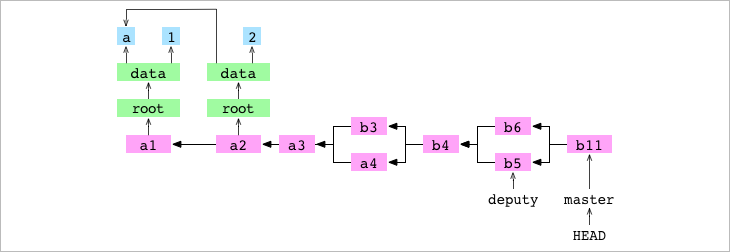
`b11`, the merge commit resulting from the conflicted, recursive merge of `b5` into `b6`
Remove a file
This diagram of the Git graph includes the commit history, the trees and blobs for the latest commit, and the working copy and index: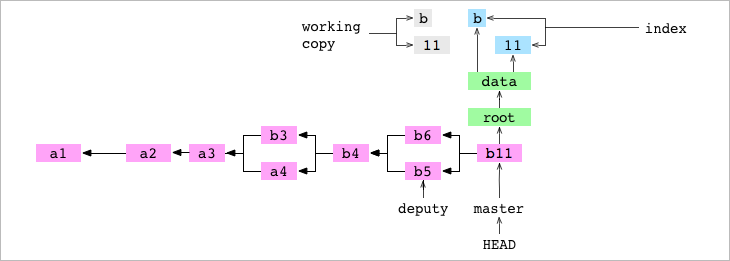
The working copy, index, `b11` commit and its tree graph
~/alpha $ git rm data/letter.txt rm 'data/letter.txt'
The user tells Git to remove
data/letter.txt.
The file is deleted from the working copy. The entry is deleted from the index.
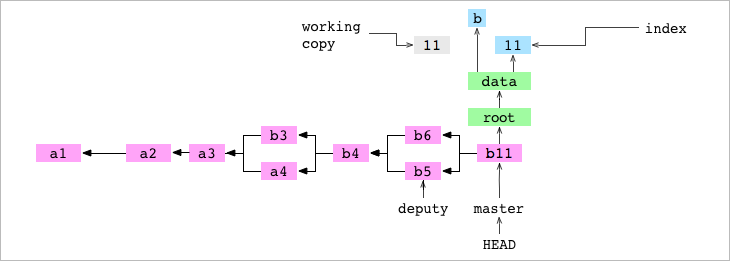
After `data/letter.txt` `rm`ed from working copy and index
~/alpha $ git commit -m '11' [master d14c7d2] 11
The user commits. As part of the commit, as always, Git builds a tree graph that represents the content of the index.
data/letter.txtis
not included in the tree graph because it is not in the index.
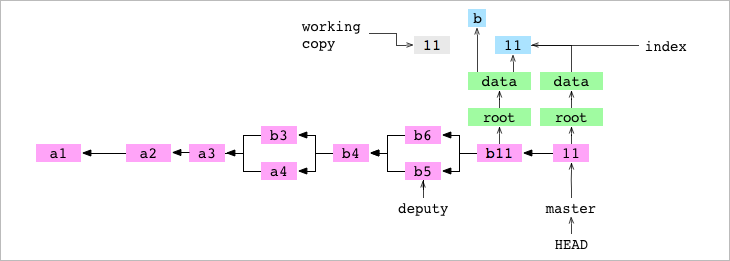
`11` commit made after `data/letter.txt` `rm`ed
Copy a repository
~/alpha $ cd .. ~ $ cp -R alpha bravo
The user copies the contents of the
alpha/repository
to the
bravo/directory. This produces
the following directory structure:
~ ├── alpha | └── data | └── number.txt └── bravo └── data └── number.txt
There is now another Git graph in the
bravodirectory:

New graph created when `alpha` `cp`ed to `bravo`
Link a repository to another repository
~ $ cd alpha ~/alpha $ git remote add bravo ../bravo
The user moves back into the
alpharepository.
They set up
bravoas a remote repository
on
alpha. This adds some lines to
the file at
alpha/.git/config:
[remote "bravo"] url = ../bravo/
These lines specify that there is a remote repository called
bravoin
the directory at
../bravo.
Fetch a branch from a remote
~/alpha $ cd ../bravo ~/bravo $ printf '12' > data/number.txt ~/bravo $ git add data/number.txt ~/bravo $ git commit -m '12' [master 94cd04d] 12
The user goes into the
bravorepository.
They set the content of
data/number.txtto
12and
commit the change to
masteron
bravo.
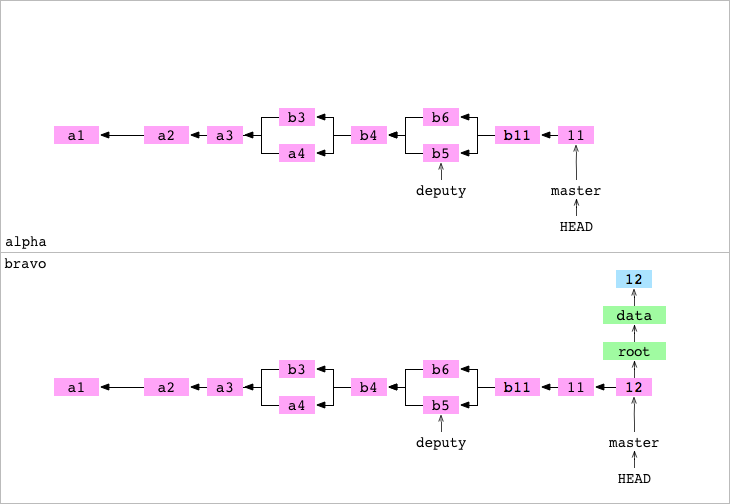
`12` commit on `bravo` repository
~/bravo $ cd ../alpha ~/alpha $ git fetch bravo master Unpacking objects: 100% From ../bravo * branch master -> FETCH_HEAD
The user goes into the
alpharepository.
They fetch
masterfrom
bravointo
alpha.
This process has four steps.
First, Git gets the hash of the commit that master is pointing at on
bravo.
This is the hash of the
12commit.
Second, Git makes a list of all the objects that the
12commit
depends on: the commit object itself, the objects in its tree graph, the ancestor commits of the
12commit
and the objects in their tree graphs. It removes from this list any objects that the
alphaobject
database already has. It copies the rest to
alpha/.git/objects/.
Third, the content of the concrete ref file at
alpha/.git/refs/remotes/bravo/masteris
set to the hash of the
12commit.
Fourth, the content of
alpha/.git/FETCH_HEADis
set to:
94cd04d93ae88a1f53a4646532b1e8cdfbc0977f branch 'master' of ../bravo
This indicates that the most recent fetch command fetched the
12commit
of
masterfrom
bravo.
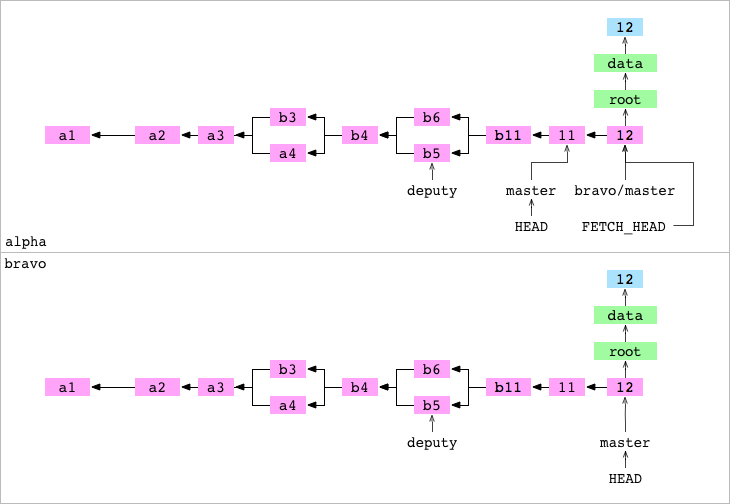
`alpha` after `bravo/master` fetched
Graph property: objects can be copied. This means that history can be shared between repositories.
Graph property: a repository can store remote branch refs like
alpha/.git/refs/remotes/bravo/master.
This means that a repository can record locally the state of a branch on a remote repository. It is correct at the time it is fetched but will go out of date if the remote branch changes.
Merge FETCH_HEAD
~/alpha $ git merge FETCH_HEAD Updating d14c7d2..94cd04d Fast-forward
The user merges
FETCH_HEAD.
FETCH_HEADis
just another ref. It resolves to the
12commit,
the giver.
HEADpoints at the
11commit,
the receiver. Git does a fast-forward merge and points
masterat
the
12commit.
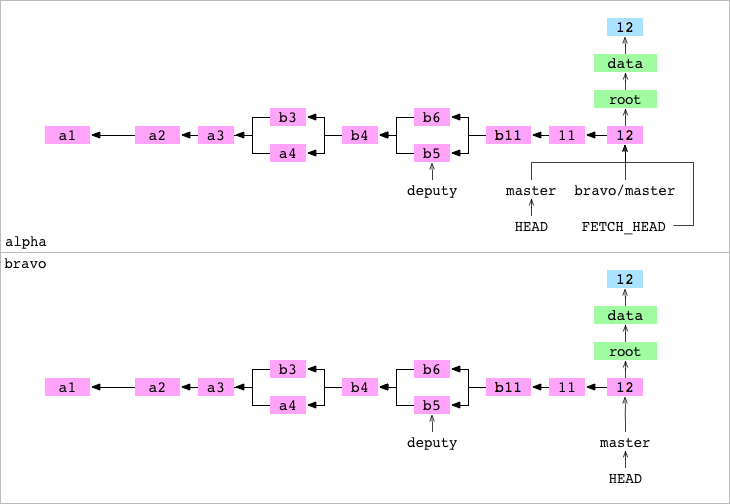
`alpha` after `FETCH_HEAD` merged
Pull a branch from a remote
~/alpha $ git pull bravo master Already up-to-date.
The user pulls
masterfrom
bravointo
alpha.
Pull is shorthand for “fetch and merge
FETCH_HEAD”.
Git does these two commands and reports that
masteris
Already up-to-date.
Clone a repository
~/alpha $ cd .. ~ $ git clone alpha charlie Cloning into 'charlie'
The user moves into the directory above. They clone
alphato
charlie.
Cloning to
charliehas similar results
to the
cpthe user did to produce
the
bravorepository. Git creates
a new directory called
charlie. It
inits
charlieas a Git repo, adds
alphaas
a remote called
origin, fetches
originand
merges
FETCH_HEAD.
Push a branch to a checked-out branch on a remote
~ $ cd alpha
~/alpha $ printf '13' > data/number.txt
~/alpha $ git add data/number.txt~/alpha $ git commit -m '13'
[master 3238468] 13
The user goes back into the
alpharepository.
They set the content of
data/number.txtto
13and
commit the change to
masteron
alpha.
~/alpha $ git remote add charlie ../charlie
They set up
charlieas
a remote repository on
alpha.
~/alpha $ git push charlie master Writing objects: 100% remote error: refusing to update checked out branch: refs/heads/master because it will make the index and work tree inconsistent
They push
masterto
charlie.
All the objects required for the
13commit
are copied to
charlie.
At this point, the push process stops. Git, as ever, tells the user what went wrong. It refuses to push to a branch that is checked out on the remote. This makes sense. A push would update
the remote index and
HEAD. This would
cause confusion if someone were editing the working copy on the remote.
At this point, the user could make a new branch, merge the
13commit
into it and push that branch to
charlie.
But, really, they want a repository that they can push to whenever they want. They want a central repository that they can push to and pull from, but that no one commits to directly. They want something like a GitHub remote. They want a bare repository.
Clone a bare repository
~/alpha $ cd .. ~ $ git clone alpha delta --bare Cloning into bare repository 'delta'
The user moves into the directory above. They clone
deltaas
a bare repository. This is an ordinary clone with two differences. The
configfile
indicates that the repository is bare. And the files that are normally stored in the
.gitdirectory
are stored in the root of the repository:
delta ├── HEAD ├── config ├── objects └── refs
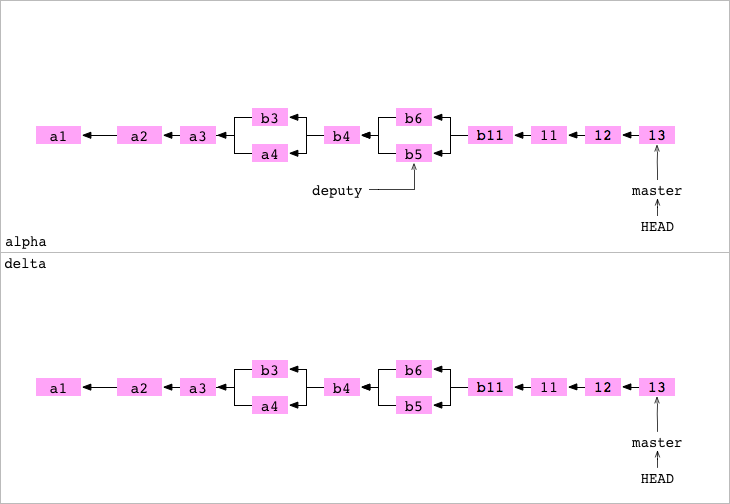
`alpha` and `delta` graphs after `alpha` cloned to `delta`
Push a branch to a bare repository
~ $ cd alpha ~/alpha $ git remote add delta ../delta
The user goes back into the
alpharepository.
They set up
deltaas a remote repository
on
alpha.
~/alpha $ printf '14' > data/number.txt
~/alpha $ git add data/number.txt~/alpha $ git commit -m '14'
[master cb51da8] 14
They set the content of
data/number.txtto
14and
commit the change to
masteron
alpha.
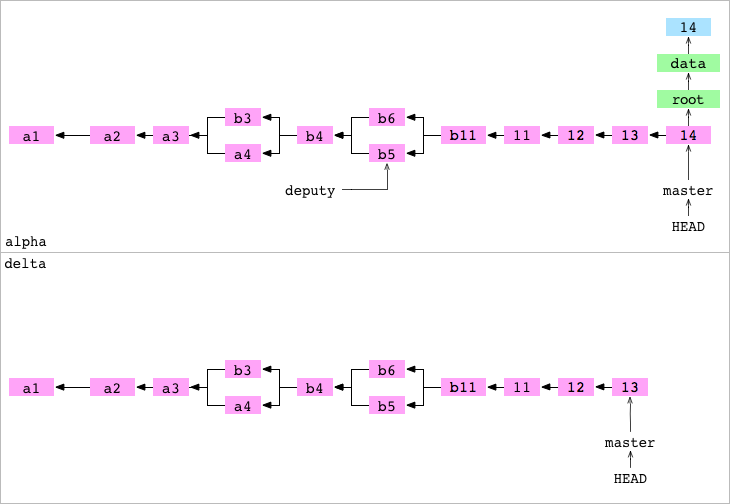
`14` commit on `alpha`
~/alpha $ git push delta master Writing objects: 100% To ../delta 3238468..cb51da8 master -> master
They push
masterto
delta.
Pushing has three steps.
First, all the objects required for the
14commit
on the
masterbranch are copied from
alpha/.git/objects/to
delta/objects/.
Second,
delta/refs/heads/masteris
updated to point at the
14commit.
Third,
alpha/.git/refs/remotes/delta/masteris
set to point at the
14commit.
alphahas
an up-to-date record of the state of
delta.

`14` commit pushed from `alpha` to `delta`
Summary
Git is built on a graph. Almost every Git command manipulates this graph. To understand Git deeply, focus on the properties of this graph, not workflows or commands.To learn more about Git, investigate the
.gitdirectory.
It’s not scary. Look inside. Change the content of files and see what happens. Create a commit by hand. Try and see how badly you can mess up a repo. Then repair it.
In this case, the hash is longer than the original content. But, all pieces of content longer than the number of characters in a hash will be expressed more concisely than the original. ↩
There is a chance that two different pieces of content will hash to the same value. But this chance is
low. ↩
git prunedeletes all objects that cannot be reached from a ref. If the user runs this command, they may lose content. ↩
git stashstores all the differences between the working copy and the
HEADcommit
in a safe place. They can be retrieved later. ↩
The
rebasecommand
can be used to add, edit and delete commits in the history. ↩
tweet
this post
Next: How I learned to (stop worrying and) love HTTP
A publication from the Recurse Center
Subscribe
Past Issues
About

code words – issue two
Git from the inside out
Mary Rose CookThis essay explains how Git works. It assumes you understand Git well enough to use it to version control your projects.
The essay focuses on the graph structure that underpins Git and the way the properties of this graph dictate Git’s behavior. Looking at fundamentals, you build your mental model on the truth
rather than on hypotheses constructed from evidence gathered while experimenting with the API. This truer model gives you a better understanding of what Git has done, what it is doing, and what it will do.
The text is structured as a series of Git commands run on a single project. At intervals, there are observations about the graph data structure that Git is built on. These observations illustrate
a property of the graph and the behavior that this property produces.
After reading, if you wish to go even deeper into Git, you can look at the heavily
annotated source code of my implementation of Git in JavaScript.
Create the project
~ $ mkdir alpha ~ $ cd alpha
The user creates
alpha,
a directory for their project.
~/alpha $ mkdir data ~/alpha $ printf 'a' > data/letter.txt
They move into the
alphadirectory
and create a directory called
data.
Inside, they create a file called
letter.txtthat
contains
a. The alpha directory looks
like this:
alpha └── data └── letter.txt
Initialize the repository
~/alpha $ git init Initialized empty Git repository
git initmakes the current directory into a Git repository. To do this, it creates a
.gitdirectory
and writes some files to it. These files define everything about the Git configuration and the history of the project. They are just ordinary files. No magic in them. The user can read and edit them with a text editor or shell. Which is to say: the user can
read and edit the history of their project as easily as their project files.
The
alphadirectory
now looks like this:
alpha ├── data | └── letter.txt └── .git ├── objects etc...
The
.gitdirectory
and its contents are Git’s. All the other files are collectively known as the working copy. They are the user’s.
Add some files
~/alpha $ git add data/letter.txt
The user runs
git addon
data/letter.txt. This
has two effects.
First, it creates a new blob file in the
.git/objects/directory.
This blob file contains the compressed content of
data/letter.txt.
Its name is derived by hashing its content. Hashing a piece of text means running a program on it that turns it into a smaller1 piece
of text that uniquely2 identifies
the original. For example, Git hashes
ato
2e65efe2a145dda7ee51d1741299f848e5bf752e.
The first two characters are used as the name of a directory inside the objects database:
.git/objects/2e/.
The rest of the hash is used as the name of the blob file that holds the content of the added file:
.git/objects/2e/65efe2a145dda7ee51d1741299f848e5bf752e.
Notice how just adding a file to Git saves its content to the
objectsdirectory.
Its content will still be safe inside Git if the user deletes
data/letter.txtfrom
the working copy.
Second,
git addadds the file to the index. The index is a list that contains every file that Git has been told to keep track of. It is stored as a file at
.git/index.
Each line of the file maps a tracked file to the hash of its content at the moment it was added. This is the index after the
git addcommand is run:
data/letter.txt 2e65efe2a145dda7ee51d1741299f848e5bf752e
The user makes a file called
data/number.txtthat
contains
1234.
~/alpha $ printf '1234' > data/number.txt
The working copy looks like this:
alpha └── data └── letter.txt└── number.txt
The user adds the file to Git.
~/alpha $ git add data
The
git addcommand creates a blob object that contains the content of
data/number.txt.
It adds an index entry for
data/number.txtthat
points at the blob. This is the index after the
git addcommand is run a second time:
data/letter.txt 2e65efe2a145dda7ee51d1741299f848e5bf752edata/number.txt 274c0052dd5408f8ae2bc8440029ff67d79bc5c3
Notice that only the files in the
datadirectory
are listed in the index, though the user ran
git add data. The
datadirectory
is not listed separately.
~/alpha $ printf '1' > data/number.txt
~/alpha $ git add data
When the user originally created
data/number.txt,
they meant to type
1, not
1234.
They make the correction and add the file to the index again. This command creates a new blob with the new content. And it updates the index entry for
data/number.txtto
point at the new blob.
Make a commit
~/alpha $ git commit -m 'a1' [master (root-commit) 774b54a] a1
The user makes the
a1commit.
Git prints some data about the commit. These data will make sense shortly.
The commit command has three steps. It creates a tree graph to represent the content of the version of the project being committed. It creates a commit object. It points the current branch
at the new commit object.
Create a tree graph
Git records the current state of the project by creating a tree graph from the index. This tree graph records the location and content of every file in the project.The graph is composed of two types of object: blobs and trees.
Blobs are stored by
git add. They represent the content of files.
Trees are stored when a commit is made. A tree represents a directory in the working copy.
Below is the tree object that records the contents of the
datadirectory
for the new commit:
100664 blob 2e65efe2a145dda7ee51d1741299f848e5bf752e letter.txt 100664 blob 56a6051ca2b02b04ef92d5150c9ef600403cb1de number.txt
The first line records everything required to reproduce
data/letter.txt.
The first part states the file’s permissions. The second part states that the content of this entry is represented by a blob, rather than a tree. The third part states the hash of the blob. The fourth part states the file’s name.
The second line records the same for
data/number.txt.
Below is the tree object for
alpha,
which is the root directory of the project:
040000 tree 0eed1217a2947f4930583229987d90fe5e8e0b74 data
The sole line in this tree points at the
datatree.

Tree graph for the `a1` commit
In the graph above, the
roottree
points at the
datatree. The
datatree
points at the blobs for
data/letter.txtand
data/number.txt.
Create a commit object
git commitcreates a commit object after creating the tree graph. The commit object is just another text file in
.git/objects/:
tree ffe298c3ce8bb07326f888907996eaa48d266db4 author Mary Rose Cook <mary@maryrosecook.com> 1424798436 -0500 committer Mary Rose Cook <mary@maryrosecook.com> 1424798436 -0500 a1
The first line points at the tree graph. The hash is for the tree object that represents the root of the working copy. That is: the
alphadirectory.
The last line is the commit message.

`a1` commit object pointing at its tree graph
Point the current branch at the new commit
Finally, the commit command points the current branch at the new commit object.Which is the current branch? Git goes to the
HEADfile
at
.git/HEADand finds:
ref: refs/heads/master
This says that
HEADis
pointing at
master.
masteris
the current branch.
HEADand
masterare
both refs. A ref is a label used by Git or the user to identify a specific commit.
The file that represents the
masterref
does not exist, because this is the first commit to the repository. Git creates the file at
.git/refs/heads/masterand
sets its content to the hash of the commit object:
74ac3ad9cde0b265d2b4f1c778b283a6e2ffbafd
(If you are typing in these Git commands as you read, the hash of your
a1commit
will be different from the hash of mine. Content objects like blobs and trees always hash to the same value. Commits do not, because they include dates and the names of their creators.)
Let’s add
HEADand
masterto
the Git graph:

`HEAD` pointing at `master` and `master` pointing at the `a1` commit
HEADpoints
at
master, as it did before the commit.
But
masternow exists and points at
the new commit object.
Make a commit that is not the first commit
Below is the Git graph after the a1commit.
The working copy and index are included.

`a1` commit shown with the working copy and index
Notice that the working copy, index, and
a1commit
all have the same content for
data/letter.txtand
data/number.txt.
The index and
HEADcommit both use
hashes to refer to blob objects, but the working copy content is stored as text in a different place.
~/alpha $ printf '2' > data/number.txt
The user sets the content of
data/number.txtto
2.
This updates the working copy, but leaves the index and
HEADcommit
as they are.

`data/number.txt` set to `2` in the working copy
~/alpha $ git add data/number.txt
The user adds the file to Git. This adds a blob containing
2to
the
objectsdirectory. It points the
index entry for
data/number.txtat
the new blob.

`data/number.txt` set to `2` in the working copy and index
~/alpha $ git commit -m 'a2' [master f0af7e6] a2
The user commits. The steps for the commit are the same as before.
First, a new tree graph is created to represent the content of the index.
The index entry for
data/number.txthas
changed. The old
datatree no longer
reflects the indexed state of the
datadirectory.
A new
datatree object must be created:
100664 blob 2e65efe2a145dda7ee51d1741299f848e5bf752e letter.txt 100664 blob d8263ee9860594d2806b0dfd1bfd17528b0ba2a4 number.txt
The new
datatree
hashes to a different value from the old
datatree.
A new
roottree must be created to
record this hash:
040000 tree 40b0318811470aaacc577485777d7a6780e51f0b data
Second, a new commit object is created.
tree ce72afb5ff229a39f6cce47b00d1b0ed60fe3556 parent 774b54a193d6cfdd081e581a007d2e11f784b9fe author Mary Rose Cook <mary@maryrosecook.com> 1424813101 -0500 committer Mary Rose Cook <mary@maryrosecook.com> 1424813101 -0500 a2
The first line of the commit object points at the new
roottree
object. The second line points at
a1:
the commit’s parent. To find the parent commit, Git went to
HEAD,
followed it to
masterand found the
commit hash of
a1.
Third, the content of the
masterbranch
file is set to the hash of the new commit.

`a2` commit

Git graph without the working copy and index
Graph property: content is stored as a tree of objects. This means that only diffs are stored in the objects database. Look at the graph above. The
a2commit
reuses the
ablob that was made before
the
a1commit. Similarly, if a whole
directory doesn’t change from commit to commit, its tree and all the blobs and trees below it can be reused. Generally, there are few content changes from commit to commit. This means that Git can store large commit histories in a small amount of space.
Graph property: each commit has a parent. This means that a repository can store the history of a project.
Graph property: refs are entry points to one part of the commit history or another. This means that commits can be given meaningful names. The user organizes their
work into lineages that are meaningful to their project with concrete refs like
fix-for-bug-376.
Git uses symbolic refs like
HEAD,
MERGE_HEADand
FETCH_HEADto
support commands that manipulate the commit history.
Graph property: the nodes in the
objects/directory
are immutable. This means that content is edited, not deleted. Every piece of content ever added and every commit ever made is somewhere in the
objectsdirectory3.
Graph property: refs are mutable. Therefore, the meaning of a ref can change. The commit that
masterpoints
at might be the best version of a project at the moment, but, soon enough, it will be superseded by a newer and better commit.
Graph property: the working copy and the commits pointed at by refs are readily available, but other commits are not. This means that recent history is easier to recall,
but that it also changes more often. Or: Git has a fading memory that must be jogged with increasingly vicious prods.
The working copy is the easiest point in history to recall because it is in the root of the repository. Recalling it doesn’t even require a Git command. It is also the least permanent point
in history. The user can make a dozen versions of a file but Git won’t record any of them unless they are added.
The commit that
HEADpoints
at is very easy to recall. It is at the tip of the branch that is checked out. To see its content, the user can just stash4 and
then examine the working copy. At the same time,
HEADis
the most frequently changing ref.
The commit that a concrete ref points at is easy to recall. The user can simply check out that branch. The tip of a branch changes less often than
HEAD,
but often enough for the meaning of a branch name to be changeable.
It is difficult to recall a commit that is not pointed at by any ref. The further the user goes from a ref, the harder it will be for them to construct the meaning of a commit. But the further
back they go, the less likely it is that someone will have changed history since they last looked5.
Check out a commit
~/alpha $ git checkout 37888c2 You are in 'detached HEAD' state...
The user checks out the
a2commit
using its hash. (If you are running these Git commands, this one won’t work. Use
git logto find the hash of your
a2commit.)
Checking out has four steps.
First, Git gets the
a2commit
and gets the tree graph it points at.
Second, it writes the file entries in the tree graph to the working copy. This results in no changes. The working copy already has the content of the tree graph being written to it because
HEADwas
already pointing via
masterat the
a2commit.
Third, Git writes the file entries in the tree graph to the index. This, too, results in no changes. The index already has the content of the
a2commit.
Fourth, the content of
HEADis
set to the hash of the
a2commit:
f0af7e62679e144bb28c627ee3e8f7bdb235eee9
Setting the content of
HEADto
a hash puts the repository in the detached
HEADstate.
Notice in the graph below that
HEADpoints
directly at the
a2commit, rather
than pointing at
master.

Detached `HEAD` on `a2` commit
~/alpha $ printf '3' > data/number.txt
~/alpha $ git add data/number.txt~/alpha $ git commit -m 'a3'
[detached HEAD 3645a0e] a3
The user sets the content of
data/number.txtto
3and
commits the change. Git goes to
HEADto
get the parent of the
a3commit. Instead
of finding and following a branch ref, it finds and returns the hash of the
a2commit.
Git updates
HEADto
point directly at the hash of the new
a3commit.
The repository is still in the detached
HEADstate.
It is not on a branch because no commit points at either
a3or
one of its descendants. This means it is easy to lose.
From now on, trees and blobs will mostly be omitted from the graph diagrams.

`a3` commit that is not on a branch
Create a branch
~/alpha $ git branch deputy
The user creates a new branch called
deputy.
This just creates a new file at
.git/refs/heads/deputythat
contains the hash that
HEADis pointing
at: the hash of the
a3commit.
Graph property: branches are just refs and refs are just files. This means that Git branches are lightweight.
The creation of the
deputybranch
puts the new
a3commit safely on a
branch.
HEADis still detached because
it still points directly at a commit.

`a3` commit now on the `deputy` branch
Check out a branch
~/alpha $ git checkout master Switched to branch 'master'
The user checks out the
masterbranch.
First, Git gets the
a2commit
that
masterpoints at and gets the
tree graph the commit points at.
Second, Git writes the file entries in the tree graph to the files of the working copy. This sets the content of
data/number.txtto
2.
Third, Git writes the file entries in the tree graph to the index. This updates the entry for
data/number.txtto
the hash of the
2blob.
Fourth, Git points
HEADat
masterby
changing its content from a hash to:
ref: refs/heads/master

`master` checked out and pointing at the `a2` commit
Check out a branch that is incompatible with the working copy
~/alpha $ printf '789' > data/number.txt ~/alpha $ git checkout deputy Your changes to these files would be overwritten by checkout: data/number.txt Commit your changes or stash them before you switch branches.
The user accidentally sets the content of
data/number.txtto
789.
They try to check out
deputy. Git prevents
the check out.
HEADpoints
at
masterwhich points at
a2where
data/number.txtreads
2.
deputypoints
at
a3where
data/number.txtreads
3.
The working copy version of
data/number.txtreads
789.
All these versions are different and the differences must be resolved.
Git could replace the working copy version of
data/number.txtwith
the version in the commit being checked out. But it avoids data loss at all costs.
Git could merge the working copy version with the version being checked out. But this is complicated.
So, Git aborts the check out.
~/alpha $ printf '2' > data/number.txt~/alpha $ git checkout deputy
Switched to branch 'deputy'
The user notices that they accidentally edited
data/number.txtand
sets the content back to
2. They check
out
deputysuccessfully.

`deputy` checked out
Merge an ancestor
~/alpha $ git merge master Already up-to-date.
The user merges
masterinto
deputy.
Merging two branches means merging two commits. The first commit is the one that
deputypoints
at: the receiver. The second commit is the one that
masterpoints
at: the giver. For this merge, Git does nothing. It reports it is
Already up-to-date..
Graph property: the series of commits in the graph are interpreted as a series of changes made to the content of the repository. This means that, in a merge, if the
giver commit is an ancestor of the receiver commit, Git will do nothing. Those changes have already been incorporated.
Merge a descendent
~/alpha $ git checkout master Switched to branch 'master'
The user checks out
master.

`master` checked out and pointing at the `a2` commit
~/alpha $ git merge deputy Fast-forward
They merge
deputyinto
master.
Git discovers that the receiver commit,
a2,
is an ancestor of the giver commit,
a3.
It can do a fast-forward merge.
It gets the giver commit and gets the tree graph that it points at. It writes the file entries in the tree graph to the working copy and the index. It “fast-forwards”
masterto
point at
a3.

`a3` commit from `deputy` fast-forward merged into `master`
Graph property: the series of commits in the graph are interpreted as a series of changes made to the content of the repository. This means that, in a merge, if the
giver is a descendent of the receiver, history is not changed. There is already a sequence of commits that describe the change to make: the sequence of commits between the receiver and the giver. But, though the Git history doesn’t change, the Git graph does
change. The concrete ref that
HEADpoints
at is updated to point at the giver commit.
Merge two commits from different lineages
~/alpha $ printf '4' > data/number.txt
~/alpha $ git add data/number.txt~/alpha $ git commit -m 'a4'
[master 7b7bd9a] a4
The user sets the content of
number.txtto
4and
commits the change to
master.
~/alpha $ git checkout deputy
Switched to branch 'deputy'
~/alpha $ printf 'b' > data/letter.txt
~/alpha $ git add data/letter.txt~/alpha $ git commit -m 'b3'
[deputy 982dffb] b3
The user checks out
deputy.
They set the content of
data/letter.txtto
band
commit the change to
deputy.

`a4` committed to `master`, `b3` committed to `deputy` and `deputy` checked out
Graph property: commits can share parents. This means that new lineages can be created in the commit history.
Graph property: commits can have multiple parents. This means that separate lineages can be joined by a commit with two parents: a merge commit.
~/alpha $ git merge master -m 'b4' Merge made by the 'recursive' strategy.
The user merges
masterinto
deputy.
Git discovers that the receiver,
b3,
and the giver,
a4, are in different
lineages. It makes a merge commit. This process has eight steps.
First, Git writes the hash of the giver commit to a file at
alpha/.git/MERGE_HEAD.
The presence of this file tells Git it is in the middle of merging.
Second, Git finds the base commit: the most recent ancestor that the receiver and giver commits have in common.

`a3`, the base commit of `a4` and `b3`
Graph property: commits have parents. This means that it is possible to find the point at which two lineages diverged. Git traces backwards from
b3to
find all its ancestors and backwards from
a4to
find all its ancestors. It finds the most recent ancestor shared by both lineages,
a3.
This is the base commit.
Third, Git generates the indices for the base, receiver and giver commits from their tree graphs.
Fourth, Git generates a diff that combines the changes made to the base by the receiver commit and the giver commit. This diff is a list of file paths that point to a change: add, remove, modify
or conflict.
Git gets the list of all the files that appear in the base, receiver or giver indices. For each one, it compares the index entries to decide the change to make to the file. It writes a corresponding
entry to the diff. In this case, the diff has two entries.
The first entry is for
data/letter.txt.
The content of this file is
ain the
base,
bin the receiver and
ain
the giver. The content is different in the base and receiver. But it is the same in the base and giver. Git sees that the content was modified by the receiver, but not the giver. The diff entry for
data/letter.txtis
a modification, not a conflict.
The second entry in the diff is for
data/number.txt.
In this case, the content is the same in the base and receiver, and different in the giver. The diff entry for
data/letter.txtis
also a modification.
Graph property: it is possible to find the base commit of a merge. This means that, if a file has changed from the base in just the receiver or giver, Git can automatically
resolve the merge of that file. This reduces the work the user must do.
Fifth, the changes indicated by the entries in the diff are applied to the working copy. The content of
data/letter.txtis
set to
band the content of
data/number.txtis
set to
4.
Sixth, the changes indicated by the entries in the diff are applied to the index. The entry for
data/letter.txtis
pointed at the
bblob and the entry
for
data/number.txtis pointed at
the
4blob.
Seventh, the updated index is committed:
tree 20294508aea3fb6f05fcc49adaecc2e6d60f7e7d parent 982dffb20f8d6a25a8554cc8d765fb9f3ff1333b parent 7b7bd9a5253f47360d5787095afc5ba56591bfe7 author Mary Rose Cook <mary@maryrosecook.com> 1425596551 -0500 committer Mary Rose Cook <mary@maryrosecook.com> 1425596551 -0500 b4
Notice that the commit has two parents.
Eighth, Git points the current branch,
deputy,
at the new commit.

`b4`, the merge commit resulting from the recursive merge of `a4` into `b3`
Merge two commits from different lineages that both modify the same file
~/alpha $ git checkout master Switched to branch 'master'~/alpha $ git merge deputy Fast-forward
The user checks out
master.
They merge
deputyinto
master.
This fast-forwards
masterto the
b4commit.
masterand
deputynow
point at the same commit.

`deputy` merged into `master` to bring `master` up to the latest commit, `b4`
~/alpha $ git checkout deputy
Switched to branch 'deputy'
~/alpha $ printf '5' > data/number.txt
~/alpha $ git add data/number.txt~/alpha $ git commit -m 'b5'
[deputy bd797c2] b5
The user checks out
deputy.
They set the content of
data/number.txtto
5and
commit the change to
deputy.
~/alpha $ git checkout master Switched to branch 'master'~/alpha $ printf '6' > data/number.txt
~/alpha $ git add data/number.txt~/alpha $ git commit -m 'b6'
[master 4c3ce18] b6
The user checks out
master.
They set the content of
data/number.txtto
6and
commit the change to
master.

`b5` commit on `deputy` and `b6` commit on `master`
~/alpha $ git merge deputy CONFLICT in data/number.txt Automatic merge failed; fix conflicts and commit the result.
The user merges
deputyinto
master.
There is a conflict and the merge is paused. The process for a conflicted merge follows the same first six steps as the process for an unconflicted merge: set
.git/MERGE_HEAD,
find the base commit, generate the indices of the base, receiver and giver commits, create a diff, update the working copy and update the index. Because of the conflict, the seventh commit step and eighth ref update step are never taken. Let’s go through the
steps again and see what happens.
First, Git writes the hash of the giver commit to a file at
.git/MERGE_HEAD.

`MERGE_HEAD` written during merge of `b5` into `b6`
Second, Git finds the base commit,
b4.
Third, Git generates the indices for the base, receiver and giver commits.
Fourth, Git generates a diff that combines the changes made to the base by the receiver commit and the giver commit. This diff is a list of file paths that point to a change: add, remove, modify
or conflict.
In this case, the diff contains only one entry:
data/number.txt.
The entry is marked as a conflict because the content for
data/number.txtis
different in the receiver, giver and base.
Fifth, the changes indicated by the entries in the diff are applied to the working copy. For a conflicted area, Git writes both versions to the file in the working copy. The content of
data/number.txtis
set to:
<<<<<<< HEAD 6 ======= 5 >>>>>>> deputy
Sixth, the changes indicated by the entries in the diff are applied to the index. Entries in the index are uniquely identified by a combination of their file path and stage. The entry for an
unconflicted file has a stage of
0.
Before this merge, the index looked like this, where the
0s
are stage values:
0 data/letter.txt 63d8dbd40c23542e740659a7168a0ce3138ea748 0 data/number.txt 62f9457511f879886bb7728c986fe10b0ece6bcb
After the merge diff is written to the index, the index looks like this:
0 data/letter.txt 63d8dbd40c23542e740659a7168a0ce3138ea748 1 data/number.txt bf0d87ab1b2b0ec1a11a3973d2845b42413d9767 2 data/number.txt 62f9457511f879886bb7728c986fe10b0ece6bcb 3 data/number.txt 7813681f5b41c028345ca62a2be376bae70b7f61
The entry for
data/letter.txtat
stage
0is the same as it was before
the merge. The entry for
data/number.txtat
stage
0is gone. There are three new
entries in its place. The entry for stage
1has
the hash of the base
data/number.txtcontent.
The entry for stage
2has the hash
of the receiver
data/number.txtcontent.
The entry for stage
3has the hash
of the giver
data/number.txtcontent.
The presence of these three entries tells Git that
data/number.txtis
in conflict.
The merge pauses.
~/alpha $ printf '11' > data/number.txt
~/alpha $ git add data/number.txt
The user integrates the content of the two conflicting versions by setting the content of
data/number.txtto
11.
They add the file to the index. Git adds a blob containing
11.
Adding a conflicted file tells Git that the conflict is resolved. Git removes the
data/number.txtentries
for stages
1,
2and
3from
the index. It adds an entry for
data/number.txtat
stage
0with the hash of the new blob.
The index now reads:
0 data/letter.txt 63d8dbd40c23542e740659a7168a0ce3138ea748 0 data/number.txt 9d607966b721abde8931ddd052181fae905db503
~/alpha $ git commit -m 'b11' [master 251a513] b11
Seventh, the user commits. Git sees
.git/MERGE_HEADin
the repository, which tells it that a merge is in progress. It checks the index and finds there are no conflicts. It creates a new commit,
b11,
to record the content of the resolved merge. It deletes the file at
.git/MERGE_HEAD.
This completes the merge.
Eighth, Git points the current branch,
master,
at the new commit.

`b11`, the merge commit resulting from the conflicted, recursive merge of `b5` into `b6`
Remove a file
This diagram of the Git graph includes the commit history, the trees and blobs for the latest commit, and the working copy and index:
The working copy, index, `b11` commit and its tree graph
~/alpha $ git rm data/letter.txt rm 'data/letter.txt'
The user tells Git to remove
data/letter.txt.
The file is deleted from the working copy. The entry is deleted from the index.

After `data/letter.txt` `rm`ed from working copy and index
~/alpha $ git commit -m '11' [master d14c7d2] 11
The user commits. As part of the commit, as always, Git builds a tree graph that represents the content of the index.
data/letter.txtis
not included in the tree graph because it is not in the index.

`11` commit made after `data/letter.txt` `rm`ed
Copy a repository
~/alpha $ cd .. ~ $ cp -R alpha bravo
The user copies the contents of the
alpha/repository
to the
bravo/directory. This produces
the following directory structure:
~ ├── alpha | └── data | └── number.txt └── bravo └── data └── number.txt
There is now another Git graph in the
bravodirectory:

New graph created when `alpha` `cp`ed to `bravo`
Link a repository to another repository
~ $ cd alpha ~/alpha $ git remote add bravo ../bravo
The user moves back into the
alpharepository.
They set up
bravoas a remote repository
on
alpha. This adds some lines to
the file at
alpha/.git/config:
[remote "bravo"] url = ../bravo/
These lines specify that there is a remote repository called
bravoin
the directory at
../bravo.
Fetch a branch from a remote
~/alpha $ cd ../bravo ~/bravo $ printf '12' > data/number.txt ~/bravo $ git add data/number.txt ~/bravo $ git commit -m '12' [master 94cd04d] 12
The user goes into the
bravorepository.
They set the content of
data/number.txtto
12and
commit the change to
masteron
bravo.

`12` commit on `bravo` repository
~/bravo $ cd ../alpha ~/alpha $ git fetch bravo master Unpacking objects: 100% From ../bravo * branch master -> FETCH_HEAD
The user goes into the
alpharepository.
They fetch
masterfrom
bravointo
alpha.
This process has four steps.
First, Git gets the hash of the commit that master is pointing at on
bravo.
This is the hash of the
12commit.
Second, Git makes a list of all the objects that the
12commit
depends on: the commit object itself, the objects in its tree graph, the ancestor commits of the
12commit
and the objects in their tree graphs. It removes from this list any objects that the
alphaobject
database already has. It copies the rest to
alpha/.git/objects/.
Third, the content of the concrete ref file at
alpha/.git/refs/remotes/bravo/masteris
set to the hash of the
12commit.
Fourth, the content of
alpha/.git/FETCH_HEADis
set to:
94cd04d93ae88a1f53a4646532b1e8cdfbc0977f branch 'master' of ../bravo
This indicates that the most recent fetch command fetched the
12commit
of
masterfrom
bravo.

`alpha` after `bravo/master` fetched
Graph property: objects can be copied. This means that history can be shared between repositories.
Graph property: a repository can store remote branch refs like
alpha/.git/refs/remotes/bravo/master.
This means that a repository can record locally the state of a branch on a remote repository. It is correct at the time it is fetched but will go out of date if the remote branch changes.
Merge FETCH_HEAD
~/alpha $ git merge FETCH_HEAD Updating d14c7d2..94cd04d Fast-forward
The user merges
FETCH_HEAD.
FETCH_HEADis
just another ref. It resolves to the
12commit,
the giver.
HEADpoints at the
11commit,
the receiver. Git does a fast-forward merge and points
masterat
the
12commit.

`alpha` after `FETCH_HEAD` merged
Pull a branch from a remote
~/alpha $ git pull bravo master Already up-to-date.
The user pulls
masterfrom
bravointo
alpha.
Pull is shorthand for “fetch and merge
FETCH_HEAD”.
Git does these two commands and reports that
masteris
Already up-to-date.
Clone a repository
~/alpha $ cd .. ~ $ git clone alpha charlie Cloning into 'charlie'
The user moves into the directory above. They clone
alphato
charlie.
Cloning to
charliehas similar results
to the
cpthe user did to produce
the
bravorepository. Git creates
a new directory called
charlie. It
inits
charlieas a Git repo, adds
alphaas
a remote called
origin, fetches
originand
merges
FETCH_HEAD.
Push a branch to a checked-out branch on a remote
~ $ cd alpha
~/alpha $ printf '13' > data/number.txt
~/alpha $ git add data/number.txt~/alpha $ git commit -m '13'
[master 3238468] 13
The user goes back into the
alpharepository.
They set the content of
data/number.txtto
13and
commit the change to
masteron
alpha.
~/alpha $ git remote add charlie ../charlie
They set up
charlieas
a remote repository on
alpha.
~/alpha $ git push charlie master Writing objects: 100% remote error: refusing to update checked out branch: refs/heads/master because it will make the index and work tree inconsistent
They push
masterto
charlie.
All the objects required for the
13commit
are copied to
charlie.
At this point, the push process stops. Git, as ever, tells the user what went wrong. It refuses to push to a branch that is checked out on the remote. This makes sense. A push would update
the remote index and
HEAD. This would
cause confusion if someone were editing the working copy on the remote.
At this point, the user could make a new branch, merge the
13commit
into it and push that branch to
charlie.
But, really, they want a repository that they can push to whenever they want. They want a central repository that they can push to and pull from, but that no one commits to directly. They want something like a GitHub remote. They want a bare repository.
Clone a bare repository
~/alpha $ cd .. ~ $ git clone alpha delta --bare Cloning into bare repository 'delta'
The user moves into the directory above. They clone
deltaas
a bare repository. This is an ordinary clone with two differences. The
configfile
indicates that the repository is bare. And the files that are normally stored in the
.gitdirectory
are stored in the root of the repository:
delta ├── HEAD ├── config ├── objects └── refs

`alpha` and `delta` graphs after `alpha` cloned to `delta`
Push a branch to a bare repository
~ $ cd alpha ~/alpha $ git remote add delta ../delta
The user goes back into the
alpharepository.
They set up
deltaas a remote repository
on
alpha.
~/alpha $ printf '14' > data/number.txt
~/alpha $ git add data/number.txt~/alpha $ git commit -m '14'
[master cb51da8] 14
They set the content of
data/number.txtto
14and
commit the change to
masteron
alpha.

`14` commit on `alpha`
~/alpha $ git push delta master Writing objects: 100% To ../delta 3238468..cb51da8 master -> master
They push
masterto
delta.
Pushing has three steps.
First, all the objects required for the
14commit
on the
masterbranch are copied from
alpha/.git/objects/to
delta/objects/.
Second,
delta/refs/heads/masteris
updated to point at the
14commit.
Third,
alpha/.git/refs/remotes/delta/masteris
set to point at the
14commit.
alphahas
an up-to-date record of the state of
delta.

`14` commit pushed from `alpha` to `delta`
Summary
Git is built on a graph. Almost every Git command manipulates this graph. To understand Git deeply, focus on the properties of this graph, not workflows or commands.To learn more about Git, investigate the
.gitdirectory.
It’s not scary. Look inside. Change the content of files and see what happens. Create a commit by hand. Try and see how badly you can mess up a repo. Then repair it.
In this case, the hash is longer than the original content. But, all pieces of content longer than the number of characters in a hash will be expressed more concisely than the original. ↩
There is a chance that two different pieces of content will hash to the same value. But this chance is
low. ↩
git prunedeletes all objects that cannot be reached from a ref. If the user runs this command, they may lose content. ↩
git stashstores all the differences between the working copy and the
HEADcommit
in a safe place. They can be retrieved later. ↩
The
rebasecommand
can be used to add, edit and delete commits in the history. ↩
tweet
this post
Next: How I learned to (stop worrying and) love HTTP
A publication from the Recurse Center
Subscribe
Past Issues
About
相关文章推荐
- Git From the Inside Out
- 布置Git环境Your working copy is out of date. Try pulling from the remote to get the latest change
- Xcode4 布置Git环境Your working copy is out of date. Try pulling from the remote to get the latest change
- Xcode4 布置Git环境Your working copy is out of date. Try pulling from the remote to get the latest change
- The WPF Tab Control - Inside and Out
- What does it mean to be an Open Source author? A story from the inside
- print out the path from one node to another in binary tree
- java.lang.OutOfMemoryError thrown from the UncaughtExceptionHandler in thread 报错解决
- No Way Out (Single Version) (Theme From Brother Bear) - Phil Collins 歌词
- JVM - Concept and Lifetime (From book "Inside the Java Virtual Machine")
- Spying Window Messages from the Inside
- How can I recover a file that I deleted in my local repo from the remote repo in Git?
- Inside QT Series (一):Let’s go, Starting From the QObject
- Standing out from the competition
- Advanced Visual Effects with OpenGL - Inside the GDC 2006(From GameDev.net)
- Inside Qt Series (一):Let’s go, Starting From the QObject
- The WPF Tab Control - Inside and Out
- Inside Qt Series (一):Starting From the QObject
- ELF format -- How programs look from the inside
- Inside Qt Series (一):Starting From the QObject
